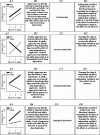Equivalence class formation: a method for teaching statistical interactions
- PMID: 20190920
- PMCID: PMC2741420
- DOI: 10.1901/jaba.2009.42-575
Equivalence class formation: a method for teaching statistical interactions
Abstract
Many students struggle with statistical concepts such as interaction. In an experimental group, participants took a paper-and-pencil test and then were given training to establish equivalent classes containing four different statistical interactions. All participants formed the equivalence classes and showed maintenance when probes contained novel negative exemplars. Thereafter, participants took a second paper-and-pencil test. Participants in the control group received two versions of the paper-and-pencil test without equivalence-based instruction. All participants in the experimental group showed increased paper-and-pencil test scores after forming the interaction-indicative equivalence classes. Class-indicative responding also generalized to novel exemplars and the novel question format used in the paper-and-pencil test. Test scores did not change with repetition for control group participants. Implications for behavioral diagnostics and teaching technology are discussed.
Keywords: college students; computer-based training; equivalence classes; generalization to novel exemplars.
Figures





References
-
- Adams B.J, Fields L, Verhave T. Formation of generalized equivalence classes. The Psychological Record. 1993;43:553–566.
-
- Arntzen E, Holth P. Probability of stimulus equivalence as a function of training design. The Psychological Record. 1997;47:309–320.
-
- Belanich J, Fields L. Generalized equivalence classes as response transfer networks. The Psychological Record. 2003;53:373–414.
-
- Bradstreet T.E. Teaching introductory statistics courses so that nonstatisticians experience statistical reasoning. The American Statistician. 1996;50:69–78.
-
- Branch M. Stimulus generalization, stimulus equivalence, and response hierarchies. In: Hayes S.C, Hayes L.J, Sato M, Ono K, editors. Behavior analysis of language and cognition. Reno, NV: Context Press; 1994. pp. 51–70. In.
MeSH terms
LinkOut - more resources
Full Text Sources

